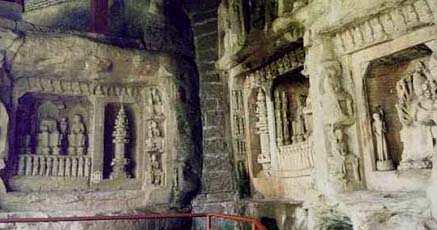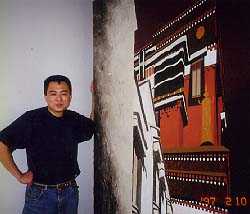
The splendor of the Dazu caves

| Saturday, July 24 Before coming to China the place I most wanted to see was Xian. As the itinerary developed, other sites made my most wanted list, including the famous gorges of the Yangtze., but the Dazu caves were definitely an afterthought. They were something to see in Congqing, which had few other sites to recommend it beyond the Stillwell Museum (which, in fact, I missed). Few of those on our Yangtze cruise were going to spend even one night in Congqing -- most were flying on to Xian or Guilin. And no one at all was going to the Dazu caves. I had to wonder whether it was worth $120 (even split four ways) when it seemed so obscure, but the pictures I had seen made it tempting. They are the best preserved Tang dynasty sculptures which still have much of their painted surfaces left, so that they could be appreciated the way they were intended. So off we went at 7:30 this morning with our non-English speaking taxi driver wearing a Holiday Inn name badge which identified him as "Wolf." The trip would take anywhere from two and a half to five hours, depending on which guidebook or person you asked, but in fact we made it to Dazu in a little more than an hour and a half on a spiffy new highway with several lengthy tunnels cutting through the mountains. The last half hour to the caves itself was on the most beautiful road I have seen in China. I kept thinking how much it reminded me of Bali: gentle hills, rice paddies gleaming in the sunshine, and quiet bamboo groves offering shade. The villagers were all up and about their morning tasks which seemed to include a great deal of walking up and down the road. Our taxi driver's response was to honk the horn rather continuously as we sped through each village, but no one seemed to mind. These villagers are still eager to welcome tourists, one assumes. We arrived at the bus car park, but a few words from the taxi driver and we headed through the gates right up to the ticket window at the entrance to the caves. We were not alone, but considering the scale and quality of the statues on display, this place remains unbelievably quiet. The guidebook describes the statues as the flowering of sculpture in the late Tang dynasty, figures more lifelike and secular than the more stylized earlier statues that reflected Buddhism's Indian roots. What struck me was not only the wonderful facial expressions on the figures and animals (one of which looked right out of Where the Wild Things Are), but also the range of human conditions which were displayed. Chronologically these caves are contemporary with the building of Chartres Cathedral -- and took about as long to complete. The statues are scattered in caves over an area of about 10 or more square miles, but two major sites are now open to the public. (There was some discussion about whether a third site is also open, but we didn't see it). The scale of these sculptures vary tremendously, from a few inches to massive figures. Some represent precepts of Confucianism, like filial piety. Others represent the paths to Buddhist enlightenment. One remarkable section shows the contrast of heaven and hell and reminded me so much of similar gothic sculptures. Our taxi driver made it very clear to me that I was not to use video (and there were signs to this effect) and photography was limited to some of the lesser niches. This had its intended effect -- Stefan, Katherine, Elene and I all bought books with impressive photographs that captured much of the thematic information. Alas, they did not capture the spirit of the place as we felt it on this beautiful summer day, walking on the timeworn (and in some places slippery, moss covered) rocks, and enjoying to serendipity of changing views as we followed the contour of the mountain. There was no rule against taking videos of the scenery, so I captured that as best I could. From the first major site we headed across the valley to the second major site. Here we found virtually no other tourists (not more than half a dozen in two hours) and we strolled at leisure along the path among slightly older statues, most lacking their coloring, but now well preserved with a new roof replacing the missing fragments of the natural overhangs. As we headed down a very slippery flight of stairs back to the parking lot, we came upon one woman selling water and a few trinkets next to a path leading up to a white pagoda. Stefan and Katherine decided to have a look at it, but I decided that I had played enough with fate on the mossy steps on the one side, and amused myself videotaping Elene bargaining over a pair of jade (or sandstone, or soapstone, or plastic) water buffalo. They really were very sweet and I ended up buying some myself (for the universal price..). But no sooner had we settled on a price for these items when the hawkers down below in the parking lot somehow sensed that money was changing hands and scurried up the path with whatever part of their wares they could carry. Chinese hawkers give a new definition to "in your face." It doesn't matter if you tell them that you don't like what they are selling. If that is all they have, they keep insisting -- make me an offer. At one point Elene managed to slip away to negotiate with just one man, and the throng descended upon me, so I headed for the safety of the parking lot. Of course, once you have bought something, no one wants to give up, so Elene and I wandered among the stalls, trying to give each shopkeeper a fair chance, and simultaneously hoping that Katherine and Stefan would hurry back. Suddenly Elene called to me that some of the men had a mah jong table next to their booth. Ah, mah jong! Did we want to play? For 2 yuan (25 cents) we could have a go at it. I was thrilled -- a chance to try my skills against some real mah jong players. So I sat down on a tiny stool and assured myself that this really was only 2 yuan -- not some secret code for 200 yuan or anything else. We hurriedly set up the tiles while I handed Elene the video camera and got it going, so that this moment -- even if considerably less ethereal than our morning in the caves -- could be preserved. The game itself was truly fun. I was lucky to have a good hand -- or whatever you call the 13 tiles you start with, and had several good breaks along the way, so that I got to take up tiles others discarded. In then end another player won, but I had clearly won the admiration of the others just for joining in. Notable, too, was the fact that for the five minutes it took to play the game, everyone was gathered around to watch, with no thoughts of selling water buffalo or regal lions to passing strangers. When Katherine and Stefan got back, we hurried into the car before they could be drawn into the market chaos, and headed down the road, only to be stopped half a mile down the road by a flat tire. Our taxi driver fixed it with no trouble, and we headed on to lunch which he shared happily with us. I have to admit that because I was with a group for three weeks, and we get buffet breakfasts, and are often hosted for dinner, Elene and I have not had a lot of practice ordering meals. Despite that we have done very well and discovered a few remarkable dishes. Among those I will try on my own when I get back are beef flavored with anise, grilled lamb with cumin, grilled tomatoes stuffed with mushrooms, and today's #1 favorite -- shoestring potatoes stir fried with ginger. These are not like our French fries -- they are still white and al dente, and who would think of ginger with potatoes? During lunch we told the driver in our best Chinese (!) that Katherine wanted to buy a mah jong set, but that we had been unable to find one last night, despite valiant efforts and lots of suggestions from various local residents. He said he knew just the place and would take us there when we got back to Congqing, and indeed he did. It was a tiny market of stalls, like so many others we had seen, but there, right across from one another, were two people selling only mah jong sets. These were not pseudo antique ones like the one I bought in Beijing for thirty dollars, but the popular current plastic variety which we bargained for $12.50 a set -- Stefan bought one, too. I was tempted to buy a second set, but they are just to heavy, so anyone who wants to play will have to come to my house. From there our driver took us to a showroom of an "art institute" which was clearly a tourist trap -- all prices were quoted in US dollars -- we didn't even see that in Beijing or Shanghai! Back at the hotel we had a glorious swim looking up at the Congqing skyline, and then a fiery hotpot dinner to celebrate our last night in Sichuan. Tomorrow we head on to Guilin and the Li River, promised to be even more beautiful than the Yangtze. Alas, Stefan and Katherine have to head back to Japan. All good wishes. Neale
|






